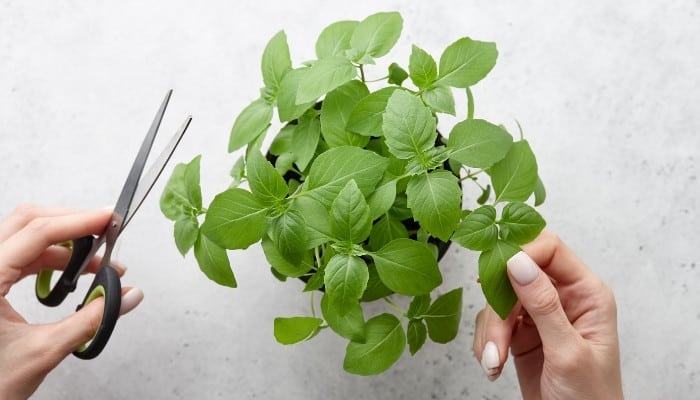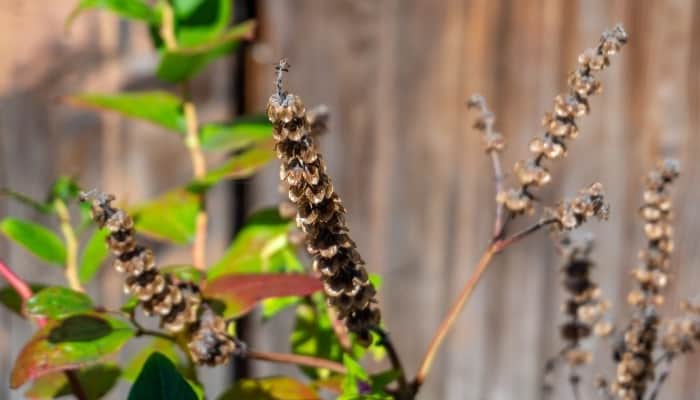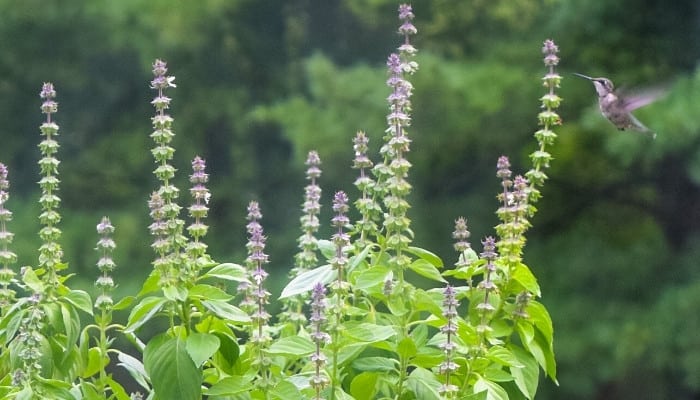Are you noticing white or purple flowers on your basil plant and wondering why? There is no need for concern as it is completely normal for these flowers to appear.
However, while these flowers are edible, they will leave the foliage bitter. So, let’s look at the best way to deal with these flowers.
Why is my basil flowering? Flowering is part of basil’s natural life cycle and occurs in late summer. The flowers will produce seeds that can be used to grow new plants next spring. To stop basil from flowering, pinch off any flowers and prune routinely. Basil may flower early due to high temperatures and water stress.
No doubt you’re growing basil for the delicious foliage, but if you’re looking to make some yummy pesto and these flowers have got you concerned, then you’ll find out exactly what to do in the following.
Basil Flowers: Why It Happens & What It Means
If you’ve enjoyed plucking basil for a few months and are now curious as to why your plant is flowering, you’re in the right place.
“Is it still safe to eat basil when it flowers?” “Should I let it flower?” “Should I stop it from flowering?”
These are common questions you may have. We’ll help you deal with all these questions and more.
Why Basil Plants Flower
Basil is an annual that produces flowers if not pruned. Flowers are a natural part of basil’s yearly life cycle – basil flowers and then yields seeds.
The seeds can then be harvested and dried for replanting.
Basil Plant Life Cycle
There are three stages in basil’s life cycle:
- Juvenile Stage – Here, basil will grow to about 12 inches (30 cm) long and will produce the most amount of leaves. During this stage, you can cut big leaves from the top, but leave smaller ones at the bottom of the plant to grow.
- Transition Stage – At this stage of basil’s life cycle, the leaves don’t grow as much. During this time, you want to prune your plant. Make two cuttings about two to three weeks apart before this stage ends.
- Productive Stage – This is when flowers start to bloom, stopping the leaves from producing. Pinching out the flowers before they bloom encourages your plant to focus on leaf production instead and extends the basil’s life cycle.
Be sure to read our article “How Long Do Basil Plants Live?” for a more complete explanation and a guide to providing the perfect growing environment for basil.
Triggers That Cause Basil Plants To Produce Flowers
Basil will produce purple or white flowers (depending on the variety of basil) during the summer if left unpruned.
There are, however, other factors that may cause shock and cause your plant to flower and set seed.
When herbs bloom under stress, we refer to it as bolting. Some fairly common triggers can cause this:
High Summer Temperatures
High temperatures in the summer will cause basil to bolt. However, the basil’s natural life cycle will also cause the plant to automatically flower before dying.
When it produces flowers, simply pinch the flowers out before they affect the flavor of your leaves.
Water Stress
The basil’s plant tissue is tender and cannot tolerate drought. It enjoys regular soakings; however, you should avoid overwatering as this can also cause stress.
The basil plant requires 1.5 inches of water every week.
Use your index finger to test the soil for moisture between each soaking to prevent overwatering. The soil should be moist rather than soggy.
Use a well-draining compost mix and ensure the container has sufficient drainage holes.
Signs That Basil Is About To Flower
The basil plant will develop purplish-white flowers, leaf development will reduce, and the plant will begin to shut down.
To keep harvesting fresh basil leaves and prevent your plant from dying, you need to check your plant frequently and pinch any flowers right away.
Prune regularly to prevent flowers from developing.
Basil plants tend to flower at the end of summer as part of their natural life cycle. Harvest half the plants’ leaves to help the plant rejuvenate and interrupt the flowering process.
Note that yellowing leaves are not necessarily a sign of imminent flowering. Rather, yellow leaves usually point to suboptimal growing conditions. Learn more here.
Is It Okay To Eat Basil After It Flowers?
Basil is safe to eat, even after it flowers. However, after flowering you may notice a mild bitter taste or, in some instances, very bitter-tasting basil leaves.
That is why you need to pinch off the flowers before they start to bloom.
Basil flowers are also edible. They have a milder flavor, so they work great as garnishes in a salad. The mild taste of the flowers is also perfect for making herbal tea.
How To Stop Basil From Flowering

Stop basil from flowering by harvesting the leaves regularly. Keep pinching fresh leaves for your pesto and other culinary uses.
Regular pinching will keep your plant from becoming leggy, and it forces the growth of new leaves.
By pruning your plant every two to three weeks, you also prevent it from flowering.
You may say pruning and harvesting are essentially the same things, but even if you do not need any fresh basil when it’s time to prune, you still need to prune it.
Don’t forget that you can store basil by drying it in the microwave or low-temp oven and keeping it in a cool, dark pantry.
Prune the plant by cutting back the stems at least 6 – 8 inches (15 – 20 cm) above the ground, but don’t prune more than a third of the plant at once.
Should You Let Basil Flower?
Allowing basil to flower is not all that bad. Quite the opposite, there may be times when it would be helpful to keep your basil flowering. So let’s take a look.
Advantages of Letting Basil Flower
If you’ve mistakenly left the flowers growing on your basil plant, it’s not the end of the world. There are many uses for basil flowers if you continue to let them grow.
You Can Eat Basil Flowers or Use Them To Make Tea
Basil flowers are perfectly edible. They make a lovely garnish to your salads, and you can brew the flowers to make a delicious herbal tea.
Taste test the flower as sometimes flowers may be bitter.
Basil Flowers Attract Bees
Honey bees are crazy about basil flowers. The bees certainly appreciate good nectar and pollen found in the white and purple flowers.
Allow the basil flowers to develop, which will attract the bees, much to the benefit of your plant and surrounding garden.
Collect the Seeds for Next Year
Saving basil seeds is an easy way to grow basil next year. You’ll find them in the spent flower heads.
Put Basil Flowers on Display
Basil flowers are cute in a bud vase. Don’t feel bad if you’ve let them grow. Appreciate them by snipping them off and putting them in a bud vase on your windowsill.
How To Harvest and Save Basil Seeds

Pick the flower heads and leave them in the sun for a few days to save the seeds. Then, crush the dried flower over a fine-mesh strainer, as the seeds are very tiny.
Store in a dry container, and you’ll have seeds to plant for the following year. Pretty easy, right?
Did you know that basil is one of the easiest plants to grow hydroponically? Check out our complete guide here.
Related Questions:
How Do I Make My Basil Bushier?
Pinching back basil leaves and even severe pruning encourages leaf growth. So, go ahead and pluck more leaves out, and your basil will grow back bushier.
Be sure to pick leaves from the top of the plant so light can reach the lower foliage of the plant.
How Do You Make Basil More Flavorful?
When your basil starts to flower, pinch the flowers out. Don’t allow the blooms to turn to seed, as this will produce a bitter flavor.
Basil is most flavorful when harvested early in the morning.
Conclusion
If your basil is flowering, you can still make good use of the flowers.
However, you should keep an eye for the first sign of flowers and pinch them out as soon as they appear if you want to keep your basil bushier and yielding fresh leaves for longer.

